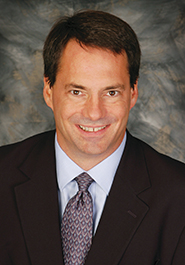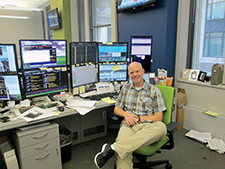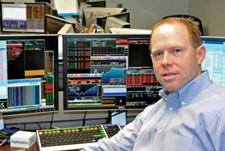Agency-only brokerage Instinet recently completed the build-out of a cash or “high-touch” trading desk in the U.S. to complement its other trading desks.
The move follows Instinet’s absorption last year of about 30 front office staff from sister company Nomura’s former equities execution services. Previously, Instinet maintained a tiny cash desk. The new desk is much larger and is staffed with 15 people mostly in New York but some are in St. Louis, San Francisco, Toronto, Los Angeles and Boston. [IMGCAp(1)]
In total, Instinet now has approximately 100 sales/trading staff in the U.S.
Nomura Holdings folded its entire global equities trading business outside of Japan into agency broker Instinet during the fall and winter of last year. This happened in a bid to cut costs and provide a unique business model amid the current global commission slump. All execution services, including cash, programs and electronic products, for the Americas, Europe, and Asia ex-Japan, were migrated to Instinet. The move didn’t affect Nomura’s research, prime brokerage and ECM businesses, which continue to be operated by Nomura’s separate broker-dealers.
[The Instinet/Nomura Wrap]
Instinet prevailed for three simple reasons: It has good technology, an established customer base and a lean operating model. Nomura’s algorithms never gained the popularity that its cousin Instinet enjoyed. However, Nomura’s high-touch desk, according to sources, stuck its neck out for clients with its wallet by aggressively committing capital to win business-only to have its head handed back with huge loss ratios. That was complementary to Instinet’s agency-only business model. The new cash desk, led by Mark Govoni, who came over from Nomura last November, runs sales and trading in New York, will not commit capital.
Jonathan Kellner, regional head, Americas, told Traders Magazine in an interview that this migration included the addition of 10 traditional cash equity traders, five of whom are sector traders, covering consumer, financials, industrials, technology and media/telecommunications, bolstering Instinet’s existing but small cash desk to about 15 people. A total of 29 front office staff came over from Nomura in the U.S.
Five of Instinet’s legacy sales traders were moved over to this new cash trading group. There will be more hires to this desk, Kellner added.
Prior to the cash desk build out, Instinet offered its clients cash trading via its hybrid desk, where sales traders manually handled orders but with executions were done electronically.
“Our expanded cash desk now operates alongside a hybrid sales trading/electronic trading desk and an execution trading desk, which we use to aggregate client flow from across the front office to improve client crossing opportunities,” Kellner told Traders Magazine. “Prior to the migration, Instinet’s single stock high-trading offering included only the hybrid desk.”
Instinet now offers its clients four trading desks to choose from: electronic or low-touch, program trading, hybrid trading desk and now a traditional cash trading desk. The hybrid desk is akin to a “one-touch” trading desk where the buyside has a single point of contact to handle its orders either electronically or manually. The cash desk provides traditional manual trading services, where a sales trader handles an order, provides market color and oversees execution.
Kellner admitted that Instinet hasn’t historically been known for its cash or high-touch trading capabilities, so his hope is that beefing up Instinet’s high-touch capabilities will help it expand its client reach and bolster revenues in the current commission environment.
“There is high demand for a cash desk backed by high-quality content and liquidity and that is why we established one,” Kellner said.
The sector traders on Instinet’s new cash trading desk also overlap with Nomura’s primary US research coverage, which clients now pay for through Instinet. That’s a win-win for clients and Instinet.
While the migration is complete and the cash desk is now successfully up and running, there were some initial concerns at Instinet about the process and combination, Kellner added. One was about whether Nomura clients would migrate to Instinet, which, since it’s a separate broker dealer, required re-papering in many cases.
“There was some risk that clients wouldn’t come because they simply did not want to change brokers,” Kellner said. “But that turned out to be minimal.”
The other issue was a clash of workflow models – Nomura committed capital for its clients while Instinet, as an agency-only broker, doesn’t. But those challenges were overcome, he added, as were initial struggles about how the new high-touch and execution desks would work within the existing Instinet framework. For example, where appropriate, Nomura sent its client orders to a centralized execution desk. Instinet did not always. Nomura also regularly used indications of interest, whereas Instinet, who had many clients trading with it for anonymity first and foremost, did not to the same extent.
For example, Nomura sent its orders to a centralized location. Instinet does not. Changing an established trader’s methodology was also a challenge. Nomura used indications of interest that were not always backed by a natural order behind it. The goal – complete a block trade. Instinet doesn’t use IOIs that do not have a firm natural order behind it and its goal isn’t necessary to complete a block trade. Rather, Kellner wants to provide liquidity across the trade size spectrum.
On the program trading side of the business, Instinet also combined its program desk with Nomura’s, roughly doubling its size to 17 staff. The two offerings were highly complementary, Kellner added, as Instinet’s strengths of technology and execution capabilities aligned well with Nomura’s, who brought an advanced index strategy, quant analysis content offering and breadth of global market coverage.
“On the program side, we now provide access to 100 percent of the developed and emerging markets and 75 percent of the frontier markets,” Kellner said. “That has given us access to quite a few programs that were not available to us previously.”










The Lights Are On at the SEC Amidst Fed Shutdown
As the federal government of the United States and its employees plan for a possible government shutdown if Congress denies appropriation funding, the Securities and Exchange Commission (SEC) is open for business.